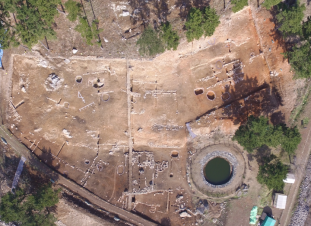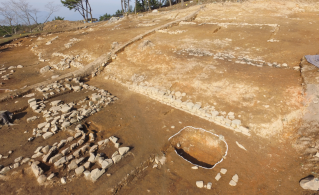"성내 건물지(거제 둔덕기성)"의 두 판 사이의 차이
(→영문) |
(→영문) |
||
| (사용자 3명의 중간 판 3개는 보이지 않습니다) | |||
| 1번째 줄: | 1번째 줄: | ||
| − | |||
{{개별안내판 | {{개별안내판 | ||
|사진= | |사진= | ||
| 5번째 줄: | 4번째 줄: | ||
|대표명칭=성내 건물지 | |대표명칭=성내 건물지 | ||
|한자=城內 建物址 | |한자=城內 建物址 | ||
| − | |영문명칭= | + | |영문명칭=Building Sites |
|종합안내판=거제 둔덕기성 | |종합안내판=거제 둔덕기성 | ||
|위도= | |위도= | ||
| 20번째 줄: | 19번째 줄: | ||
===영문=== | ===영문=== | ||
| − | ''' | + | '''Building Sites ''' |
| − | + | The sites of several buildings were discovered inside Dundeokgiseong Fortress. The buildings dated to the Three Kingdoms (57 BCE-668 CE), Unified Silla (676-935), and Goryeo (918-1392) periods and served political, administrative, military, residential, and ritual purposes. The building sites currently marked inside the fortress represent the Goryeo-period structures. | |
| − | + | Archaeological excavations conducted from 2012 to 2016 showed that when the fortress was first constructed in the Three Kingdoms period, the natural slope of the land was leveled using soil and weathered rocks to create a flat surface for building structures. In later periods, retaining walls were added and preexisting building sites were built upon to create a terraced slope that helped to effectively use the limited area inside the fortress. Excavated artifacts provided important clues for determining the function of each building. They included roof tiles, earthenware, porcelainware, stoneware, ironware, and bronzeware, namely construction materials, domestic tools, military items, and ritual vessels for warding off evil spirits. These archaeological findings aid in the understanding of other Goryeo-period fortress sites, such as Manwoldae Palace in Gaeseong and Yongjangseong Fortress on Jindo Island. | |
| − | |||
| − | |||
| − | |||
| − | |||
| − | |||
| − | |||
===영문 해설 내용=== | ===영문 해설 내용=== | ||
| − | 둔덕기성 내부에서는 | + | 둔덕기성 내부에서는 여러 건물지가 확인되었다. 이 건물들은 삼국시대, 통일신라시대, 고려시대에 지어졌으며, 정치, 행정, 군사, 생활, 제의 등의 목적으로 쓰였다. 현재 건물지는 고려시대 건물지를 중심으로 정비한 것이다. |
| − | |||
| − | |||
| − | + | 2012-2016년에 실시된 시굴조사와 발굴조사 결과, 삼국시대에 둔덕기성이 처음 축조될 때 성내 자연 경사면에 맞추어 생토 및 풍화암반층을 정리하여 건물지를 마련하였던 점이 확인되었다. 이후에는 축대를 세우고 이전 시기의 건축기단에 맞게 인공대지를 만들었으며, 이는 성내의 협소한 공간을 효율적으로 활용하기 위한 설계였다. 건물지에서 출토된 유물들은 건물지의 성격을 파악하는 데 중요한 단서를 제공한다. 출토유물에는 각종 기와류, 토기류, 자기류, 석기류, 철기류, 청동기류 등이 있으며, 크게 생활구, 무구, 진단구, 건축부재 등으로 나눌 수 있다. 이러한 고고학적 발견은 개성 만월대, 진도 용장성 등 고려시대의 성곽 유적을 이해하는 데 도움이 되는 자료이다. | |
=='''갤러리'''== | =='''갤러리'''== | ||
<gallery mode=packed heights=200px> | <gallery mode=packed heights=200px> | ||
| − | File:둔덕기성_성내건물지1.png | 성내 건물지 발굴 당시 전경(평면) | + | File:둔덕기성_성내건물지1.png | 성내 건물지 발굴 당시 전경(평면) <br/>The building sites during excavation (view from above) |
| − | File:둔덕기성_성내건물지2.png | 계단식으로 조성된 대지 발굴당시 사진 | + | File:둔덕기성_성내건물지2.png | 계단식으로 조성된 대지 발굴당시 사진 <br/>The terraced slope during excavation |
</gallery> | </gallery> | ||
2024년 4월 9일 (화) 18:21 기준 최신판
| 성내 건물지 城內 建物址 Building Sites |
|
해설문
국문
성내 건물지는 둔덕기성(屯德岐城)을 구성하는 핵심적인 시설들의 터로서, 정치ㆍ행정ㆍ군사ㆍ생활ㆍ제의(祭儀) 등과 관련된 시설이 있었던 자리로 보인다. 둔덕기성 내부 시굴조사와 발굴조사(2012년~2016년) 결과, 이러한 건물 터는 여러 개가 확인되었다. 건물지에서는 각종 기와류를 비롯하여, 토기류ㆍ자기류ㆍ석기류ㆍ철기류ㆍ청동기류 등의 유물이 나왔다. 크게 생활구ㆍ무구류ㆍ진단구ㆍ건축부재 등으로 건물지의 성격을 파악하는 중요한 단서를 제공한다.
성내 건물지는 그 층위와 그곳에서 출토된 유물 등을 볼 때 성내 경사면을 따라 삼국시대(신라), 통일신라시대, 고려시대의 순서로 지속적으로 조성되었음을 알 수 있다. 현재 건물지는 가장 후대에 조성된 고려시대 건물지를 중심으로 정비한 것이다.
먼저 삼국시대에는 성내 자연 경사면에 맞추어 생토 및 풍화암반층을 계단상으로 굴착하거나 정리하여 건물지를 마련하고, 그 자리에 건물을 지었다. 통일신라시대와 고려시대의 건물지는 자연 경사면과 이전 시기의 건축기단 등에 맞게 인공대지와 축대 등을 만들어서 새롭게 마련한 것이다. 삼국시대부터 고려시대까지 조성된 건물지 에서 보이는 계단상 대지 및 축대는 자연 경사면으로 인한 성내의 협소한 공간을 효율적으로 활용하기 위한 설계이다. 이것은 개성 만월대, 진도 용장성 왕궁지 등의 건축유적 등과 비교ㆍ연구할 수 있는 중요한 학술자료로 평가된다.
영문
Building Sites
The sites of several buildings were discovered inside Dundeokgiseong Fortress. The buildings dated to the Three Kingdoms (57 BCE-668 CE), Unified Silla (676-935), and Goryeo (918-1392) periods and served political, administrative, military, residential, and ritual purposes. The building sites currently marked inside the fortress represent the Goryeo-period structures.
Archaeological excavations conducted from 2012 to 2016 showed that when the fortress was first constructed in the Three Kingdoms period, the natural slope of the land was leveled using soil and weathered rocks to create a flat surface for building structures. In later periods, retaining walls were added and preexisting building sites were built upon to create a terraced slope that helped to effectively use the limited area inside the fortress. Excavated artifacts provided important clues for determining the function of each building. They included roof tiles, earthenware, porcelainware, stoneware, ironware, and bronzeware, namely construction materials, domestic tools, military items, and ritual vessels for warding off evil spirits. These archaeological findings aid in the understanding of other Goryeo-period fortress sites, such as Manwoldae Palace in Gaeseong and Yongjangseong Fortress on Jindo Island.
영문 해설 내용
둔덕기성 내부에서는 여러 건물지가 확인되었다. 이 건물들은 삼국시대, 통일신라시대, 고려시대에 지어졌으며, 정치, 행정, 군사, 생활, 제의 등의 목적으로 쓰였다. 현재 건물지는 고려시대 건물지를 중심으로 정비한 것이다.
2012-2016년에 실시된 시굴조사와 발굴조사 결과, 삼국시대에 둔덕기성이 처음 축조될 때 성내 자연 경사면에 맞추어 생토 및 풍화암반층을 정리하여 건물지를 마련하였던 점이 확인되었다. 이후에는 축대를 세우고 이전 시기의 건축기단에 맞게 인공대지를 만들었으며, 이는 성내의 협소한 공간을 효율적으로 활용하기 위한 설계였다. 건물지에서 출토된 유물들은 건물지의 성격을 파악하는 데 중요한 단서를 제공한다. 출토유물에는 각종 기와류, 토기류, 자기류, 석기류, 철기류, 청동기류 등이 있으며, 크게 생활구, 무구, 진단구, 건축부재 등으로 나눌 수 있다. 이러한 고고학적 발견은 개성 만월대, 진도 용장성 등 고려시대의 성곽 유적을 이해하는 데 도움이 되는 자료이다.

